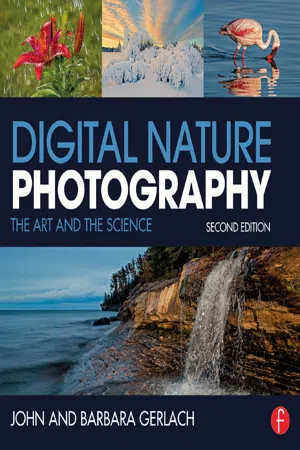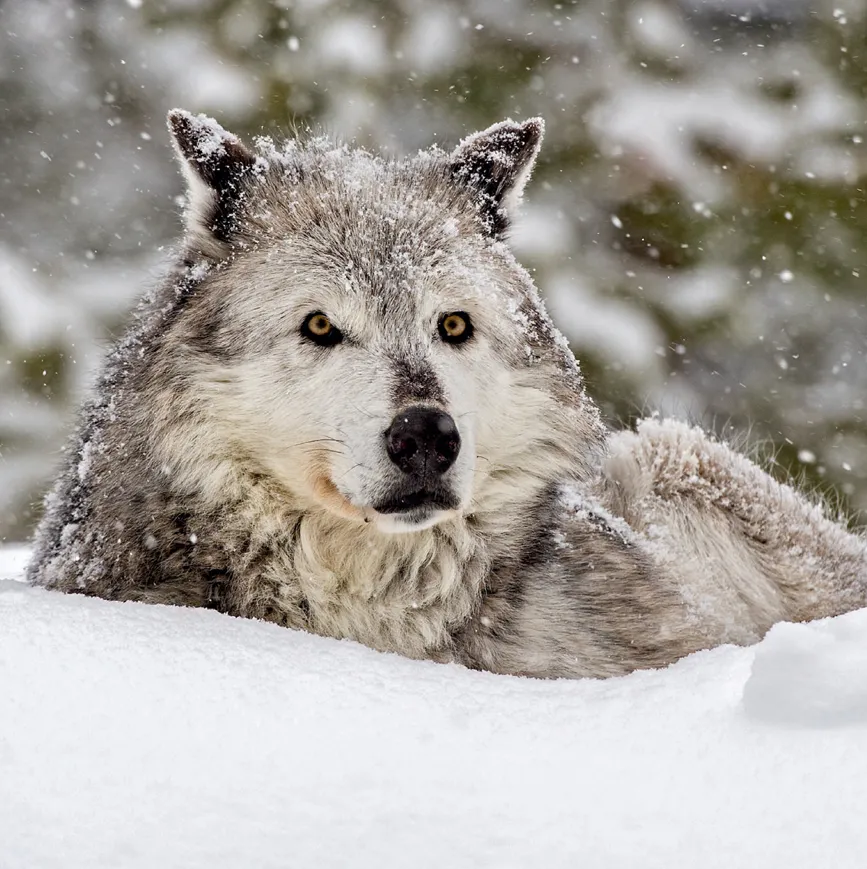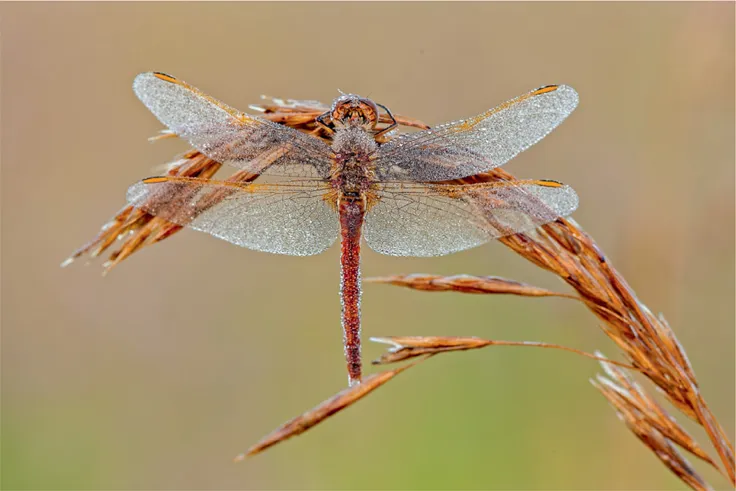![]()
We do not photograph many captive animals, but we enjoy photographing the gray wolves at the Grizzly and Wolf Discovery Center (www.grizzlydiscoveryctr.com) in West Yellowstone. We especially like photographing them during winter because their fur coats are immaculate and the snow “cleans up” their enclosure and makes the image appear wilder. Nikon D4, Nikon 200–400mm f/4 lens at 400mm, ISO 640, f/7.1, 1/500 second, Cloudy WB, manual exposure and AF-C autofocus on the back-button.
1
Cameras and Accessories
CAMERA SYSTEM CHOICES
All of the popular camera companies—Nikon, Canon, Sony, Olympus, Pentax, and Sigma—make excellent products. You can’t go wrong with any of these brands. However, Nikon and Canon produce two of the largest product lines. They offer various camera models, lens choices, and other accessories. Though having just the right equipment is important to achieving your photo goals, all of those options can bewilder a beginner. Let me shed some light on the available choices.
Barbara shoots all Nikon cameras and lenses and has done so throughout her entire career. I began with Canon in 1971, switched to Nikon ten years later, and then switched back to Canon in the late 1980s to use their newly introduced tilt/shift lenses. Today, I mostly shoot Canon equipment, but I did sometimes borrow Barbara’s fantastic Nikon 200–400mm lens when I photographed wildlife! In the spring of 2014, I bought Canon’s 200–400mm lens, so I no longer need to borrow hers. Barbara sometimes borrows my Canon camera to use Canon’s tilt/shift lenses or the fabulous Canon 65mm macro for high magnification focus stacking work. We shoot both Canon and Nikon because we genuinely like both. Knowing both systems thoroughly helps us tremendously in teaching field workshops because 90 percent of our workshop clients are shooting either Canon or Nikon.
Most likely you already have a camera and perhaps a few lenses. It makes sense to stay with your chosen system because it is expensive to switch. However, if you are deciding on a system, we suggest you look at the Canon and Nikon systems closely for four reasons:
1. Nikon and Canon offer a wide variety of cameras, lenses, and flash options.
2. Plenty of instructional materials—e-books, third-party books on the system, books on individual cameras, and websites devoted to these systems—are available.
3. Most photo instructors shoot one of these two systems. If you are shooting the same camera system as your photo instructor, they should be able to help you more.
4. If you are on a photo trip—Antarctica, for example—and your lens or camera malfunctions, the chances are much greater you can borrow what you need from another passenger if you are shooting a system that many of the other passengers are shooting.
The lesser flamingo is filtering the water for blue and green algae at Kenya’s Lake Nakuru. The flamingo is simple to photograph well if your technique is flawless. Compose the flamingo feeding on the left side to give it space to walk into the image. Be sure to include the reflection of the bird to add interest. Focus by selecting a single AF point that corresponds to the head of the bird. Set the autofocus to continuous focus to keep the bird in focus, select a fast shutter speed, and shoot many images. Having a large buffer in the camera allows you to keep shooting as the bird walks by in front of you. Nikon D200, Nikon 200–400mm f/4 lens, ISO 200, f/8, 1/500 second, Sun WB, shutter-priority at +.7 EC and AF-C autofocus on the back-button control.
KEY CAMERA FEATURES
HIGH MEGAPIXEL COUNT
The cameras sold today offer plenty of megapixels. If your camera can capture 12MP RAW files or larger, then you have enough. Having more megapixels means you can make large prints that are sharp or crop the image more while retaining satisfactory resolution.
FAST SHOOTING SPEED
Being able to shoot six or more images per second is crucial for action photography. If you tend to shoot still subjects—portraits, landscapes, still-life—then shooting speed is far less critical.
LARGE BUFFER
Most cameras can shoot images faster than they can be written to the storage media such as a Compact Flash (CF) card. Therefore, the camera has a built-in buffer where the image data are temporarily stored while waiting to be written to the card. When the buffer is full, the camera stops shooting until enough data are written to the storage media and removed from the buffer.
Photographers who tend to shoot many images quickly benefit from having a large buffer.
ADJUSTABLE SELF-TIMER
Most cameras offer an adjustable self-timer. Pressing the shutter button with the self-timer invoked gives you time to get in the picture before the camera shoots the image.
You can use the self-timer to fire the camera without touching it, which effectively produces sharper images. Gently press the shutter button with your finger. This causes the camera to shake a little, but it dissipates in a second or two. Then the camera shoots the image when the camera is perfectly still. The typical self-timer runs down in about 10 seconds. That time interval is fine if you want to be in the picture, but far too long for merely firing the camera.
Being able to set a 2-second self-timer interval is more convenient.
CABLE OR WIRELESS REMOTE RELEASE
To shoot sharper images when the camera is mounted on a tripod, fire the camera without touching it by using a cable release that attaches to the camera or a wireless release. Make sure your camera offers these options—most do.
RGB HISTOGRAM
The histogram display provides a way to more accurately determine the optimum exposure, especially when a single color in the subject dominates or the light is highly biased to a single colorcast, such as the red light at sunset or the blue light in the shade. Of course, the worst situation is a dominant color that is illuminated with light of that color. A red fox bathed in the red light of sunset is an example in which the reds are likely to be overexposed with the averaging histogram. The red channel of the RGB histogram immediately shows there is a problem with the red light that is easy to overcome by reducing the exposure.
BACK-BUTTON FOCUSING
Your camera has this feature if there is a designated AF-On button on the rear of your camera near the right side of the viewfinder. Even if you don’t have this button, most cameras offer a way to take autofocus off the shutter button and move it to a button on the rear of the camera.
Having a camera that can do this is absolutely essential as back-button focusing is an enormously precise and efficient way to hit sharp focus with autofocus!
MIRROR LOCK-UP
This mechanism allows you to lock the mirror in the upright position before shooting the image.
This produces sharper images when shooting on a tripod, especially in the shutter speed range of 1/4 to 1/30 of a second. Without mirror lock-up the camera moves slightly when you shoot because the mirror has to move out of the way to allow the light to strike the sensor.
Dew-laden dragonflies are plentiful on cool mornings in northern Michigan meadows. They roost on top of flowers and grasses and become soaked with dew by dawn. Your shooting technique is crucial for making the finest possible image. Tripping the shutter with your finger jars the camera and creates camera-shake. Instead, trip the shutter with a cable release or a wireless remote release to eliminate the image-softening effects of vibration. Canon 1D Mark III, Canon 180mm f/3.5 macro lens, ISO 200, f/8, 1/6 second, Daylight WB, manual metering and focus.
LIVE VIEW
With live view activated, you can see the image that will be captured on the LCD display before firing the camera. On many cameras, a live histogram is offered. Using a magnified live view focus is the best way to achieve critical sharp focus on all close-up and macro images.
BUILT-IN WIRELESS FLASH CONTROL
Most Nikons, some Canons, and many other camera brands that have a built-in pop-up flash on top of the camera allow the pop-up flash to be the Commander or Master controller. This means the pop-u...



